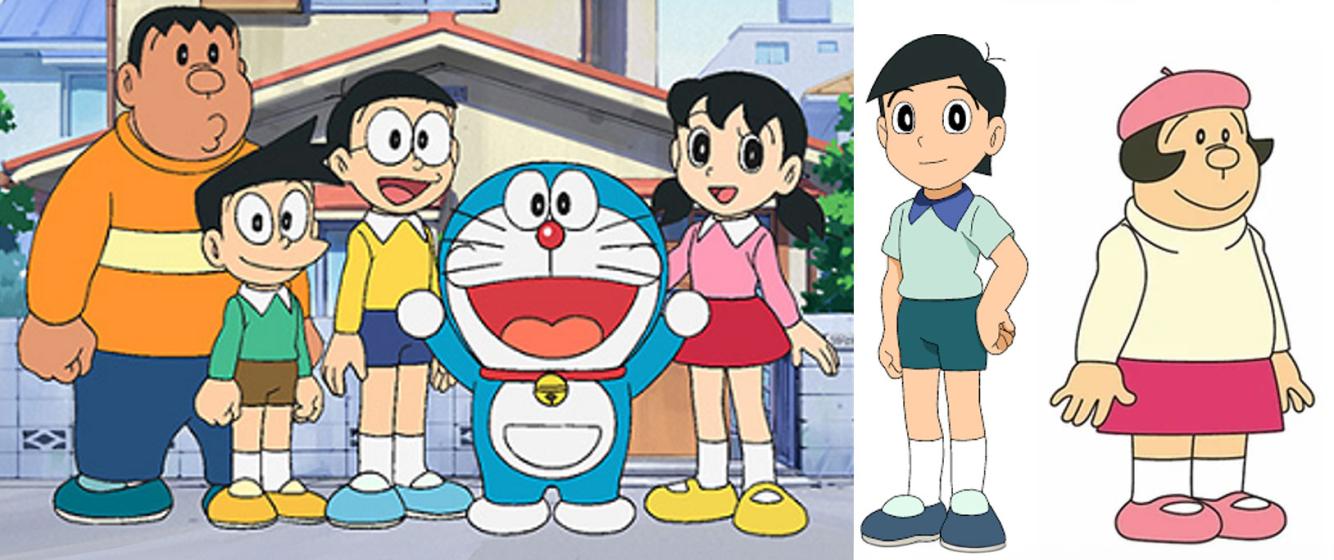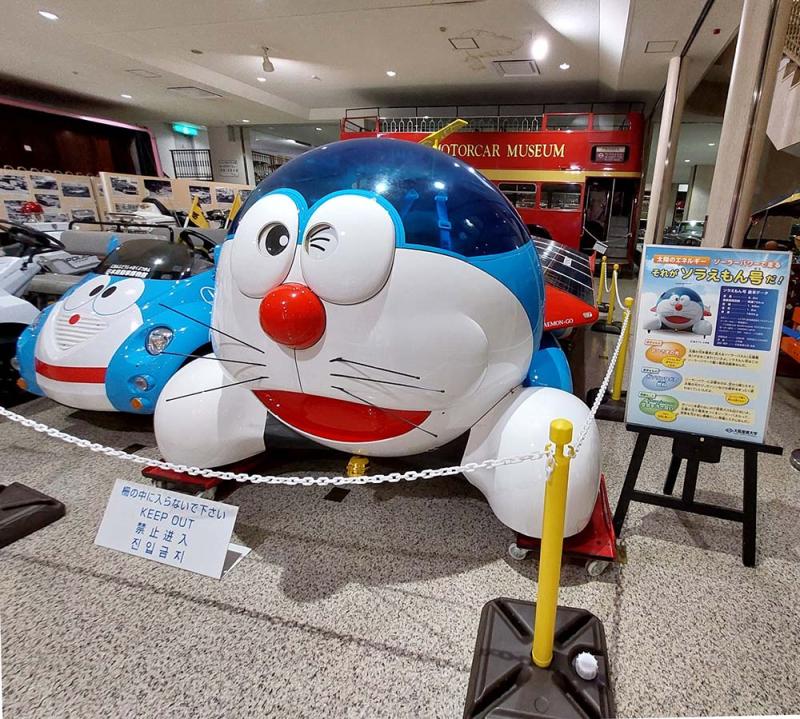
Nobita and Doraemon and friends. Jaian is on the far left. Suneo is on the left. Nobita is in the center with glasses. Doraemon is in the center as a blue robot cat. Shizuka is on the right. Dekisugi (center picture) represents Nobita’s competition. Jaiko (right picture) represents Nobita’s undesired future.
Doraemon as High Speed Growth Manga (2): Social class and Nobita’s friends
One of Japan's most beloved manga and anime concerns the fate of children. What social class will Nobita, the protagonist of Doraemon end up in? In part 1 of this deep dive into Doraemon, we looked at the popularity of this robot cat from the future as representing the aspirations of middle class youth in the Asian development state. In part 2 we look at the hidden social classes in this manga and anime, as Doraemon attempts to save Nobita from a life of mediocrity.
Nobita’s great grandson sent Doraemon, a robot cat, back in time to make sure Nobita will study. Should he become successful he will marry Shizuka, his childhood friend and become successful in life. Doraemon uses futuristic gadgets to help Nobita out of dilemmas or sometimes Nobita uses these gadgets without permission to avoid studying (usually to poor results).
Friendship plays an important role in Doraemon, as episodes show how the gang adventures together. But underneath this friendship are hints of a social divide. Official trailer from the Doraemon official website https://www.youtube.com/@Doraemon_F_Channel
Nobita is a child after all, and so one of the themes of Doraemon is childhood friendship. Although one must study, one must also have fun. Nobita goes out to play with other children during his free time. But even these friendship ties reflect a stratified society of the 1960s Japan. Nobita has friends from the blue collar world below him and the upper class world above him. Which future will he end up in?
His friend Jaian (a play on the word Giant), is the working-class warning for Nobita of what will happen to him and his family should he not study. Jaian is from a blue collar background, and his family runs a drygoods store. Reflecting the blue collar stereotype, Jaian is large for his age, darker skinned, and can become violent because he settles things with his fists, not his brains. Unlike Nobita’s white collar family who do not hit him, Jaian’s parents use beatings to discipline their son. Nobita has a frenemy relationship with Jaian - sometimes playmates, sometimes prey for Jaian to vent his frustrations on, but deep down close friends.
In fact, Nobita will end up marrying Jaian’s chubby sister Jaiko if he does not do well in school. Although it is cruel to portray young girls this way, by the standards of the 1960s, it was considered an acceptable comic device, and shows the middle class fears of the ugliness of working class life. Noteworthy though is that her mother Mrs. Gouda, runs a shop, showing the necessity of work for a blue collar family. Contrast this with Nobita’s mother Tamako, who is a full time stay at home middle-class housewife charged with running the household and making sure Nobita excels in school.
If Jaian represents the fear of falling back into the blue collar working class, then Suneo, Nobita’s spoiled wealthy friend, and Shizuka, his upper middle class love interest, represent the aspirations of the lower middle class. Suneo, the rich and arrogant child, often has toys that he flaunts to Nobita, and refuses to let Nobita play with them. As a result, Nobita, jealous with envy, often runs to Doraemon for a superior toy from the future. And Jaian seeks out Suneo to play with his new toys, and they often exclude Nobita from their activities. Just like Jaian, he is a frenemy to Nobita - sometimes his richer tormentor, and sometimes a play companion. Often, he will have a party and invite Jaian, his protector, and the pretty Shizuka, and purposely exclude Nobita.
Yet, there is some unease with moving into the upper class as well. Suneo is portrayed as stubborn and childish. One of the running jokes in Doraemon is how he wets his bed when sleeping. And it seems he has trouble making and maintaining friends and has to use his new toys to bribe Gian and Nobita to play with him.
Thus Nobita has inherited the fears of the lower middle class males: not rich enough to be accepted by the rich, and not authentically blue collar and manly enough to be accepted by the working class. Or a cynical Marxist would say that the wealthy Suneo was able to buy the labor and protection of Jaian through buying him off.
Shizuka, the object of Nobita’s desire, is portrayed as coming from a middle or upper middle class family, with violin lessons, the mark of a middle class girl, although she is a terrible musician. Nobita wants to marry her, and enter the middle class dream. She is portrayed as girly and carries around a doll, and thus represents the idealized middle class urban housewife. While Jaiko draws comics, Shizuka engages in the middle class activities of violin playing, which is the proper activity for a middle class girl.
So the two women Shizuka and Jaiko respectively represent the middle class dreams and working class fears of the lower middle class. If Nobita does not shape up and study more, he will end up marrying Jaiko and falling into the blue collar abyss, a fear of downward mobility. But if Doraemon can help him to study more, then he will end up marrying Shizuka, and lead the dream middle class with a pretty woman.
And to add to his pressure, Dekisugi, a somewhat minor character, reflects the hypercompetent and highly intelligent kid who is also a competitor to Nobita in this high-stakes academic environment. Consider him the perfect son that Asian moms encourage their children to be. If Nobita does not do well, then Dekisugi, who is an ace student, will get a good job and marry Shizuka. To make matters worse, Dekisugi does not even consider Nobita a competitor, and this kindness only makes Nobita even more jealous. Many Asian kids could relate to this rival, as they are often compared by parents to their perfect cousin or classmate.
Doraemon as a Pan-Asian lower middle class fantasy
Kids across Asia could relate to the fantasy of having gadgets to make one’s parents or the local bully fall asleep, as seen in this clip from the Doraemon official site.
When one takes a larger pan-Asian view of Doraemon, one can see that Nobita’s background resonates with the lower middle class in Asia. The situation of 1960s Japan is something that young school kids in developing nations like Vietnam can understand, since they too, like Nobita, are now the hopes of their families who got their foot into the door of middle-class respectability.
One can see this upward mobility fantasy in its portrayal of consumer technological goods. While Nobita’s family has very few tech gadgets (not even a car), Doraemon represents the future, with his reliance on gadgets galore. For many aspiring lower middle class kids in places like Thailand or Bangladesh, Doraemon, being a cat from the future, represents the consumerist technological lifestyle. While people in the west may nostalgically look at how pure and simple the lives of kids in the developing world are, the kids in these developing worlds want a future where they can afford labor saving gadgets to make their lives easier.
So while Doraemon appeals to kids because of its fanciful gadgets and themes of friendship, there is an element of social class and the developmental state that explains why this series is so beloved in other up and coming nations. Nobita is portrayed as a crybaby, often bawling to Doraemon for help. To young lower middle class children in developing economies like Vietnam,Thailand, Malaysia or Indonesia, who have to study all day and have little time for sports, Nobita’s weakness is quite relatable. Like Nobita, these children also have dreams of rising into a higher social class, or at least passing next week’s examination. And young kids trapped in the examination hell wish that they have a robot cat who can provide them with technology and friendship.
A shorter version of this post appeared in the June-July 2018 issue of Wasabi magazine.
Discussion Questions
- Who helps Nobita from the future? Why?
- Which social class does Jaian belong to? What about Suneo? What about Shizuka?
- Why is Nobita shown with friends from both lower and upper classes?
- How does Doraemon (the robot cat) reflect middle-class aspirations through helping Nobita study and grow up successful?
- In your culture, can you think of a story, show, or book where a child’s friends come from different social classes? What does it teach?
- Have you ever felt your future choices were influenced by your family’s class or hopes?
- Why might showing friends from different classes help us understand social change better?



Add new comment